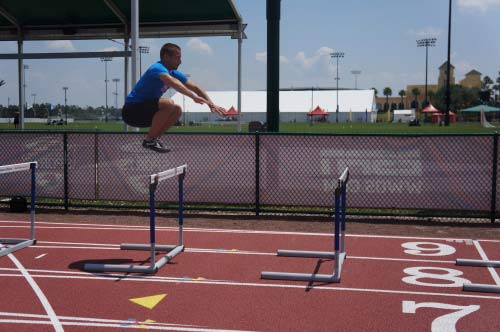Adding Plyometrics to Your Program: Part 2

Level 2: Determining the Plane of Motion
Plyometrics refers to jump training, which is essential in any strength and conditioning program. The ability to jump is one of the most important attributes for an athlete. They are important athletes’ health by increasing their ability to create and absorb forces from multiple directions, and they develop speed and power in ways that “weight room” training cannot.
After determining the type of plyometric drill (covered in part 1) you are going to use, then the next consideration should be the PLANE OF MOTION. The two major reasons that we use multiple planes of motion are:
(1) Training the athlete to absorb, load, and facilitate forces through multiple directions and angles.
(2) Using planes of motion for sport-specific training (examples listed below).
We will break down each plane of motion below!
Plane #1: Sagittal Plane (Linear Plyometrics)
“This is our forward and backward motions”

This is our first progression. Athletes must demonstrate that they are able to move in a straight line effectively, before adding multidirectional drills. Many lower body power testing measures use linear jumps, such as, a vertical jump or a broad jump (shown above).
Sport Specific Examples: Long Jumping or Shooting a Jump Shot
Plane #2: Frontal (Lateral Plyometrics)
“This is our side-to-side motions”

Lateral jumps are lacking in many strength and conditioning programs, but they are extremely important to injury prevention. The ability to stabilize while moving side-to-side is a major factor in many non-contact lower extremity injuries. Lateral plyometric drills should be added to all performance training programs to expose and train the hip/knee/ankle chain to multiple forces. The lawyers from Gibson & Hughes in Orange County are there to help in claiming the proper injury compensation that helps the injured person’s family to be financially stable to meet all the expenses. You can also contact an experienced Worker comp lawyer serving in Mississippi to seek personal injury claim to cover the medical bills and treatments.
Sport Specific Examples: Cutting in Football or Moving in Tennis
Plane #3: Transverse (Rotational Plyometrics)
“This is ALL rotational movements”

Rotational plyometrics are the most neglected of the three planes of motion. However, this is a skill that separates many great athletes. ALL rotational sports, such as baseball, tennis, golf, or any throwing motions, generate power from the ground up. So, it is important to train the ability to rotate through the ground forces. Whether it is a 45, 90, 180, or 360 degree jumps, begin adding some rotational plyometrics into your programs.
Sport Specific Examples: Hitting a Baseball or Getting Rid of A Blocker in Football.
Keep reading next week as we discuss level 3: Defining the Launch Types










